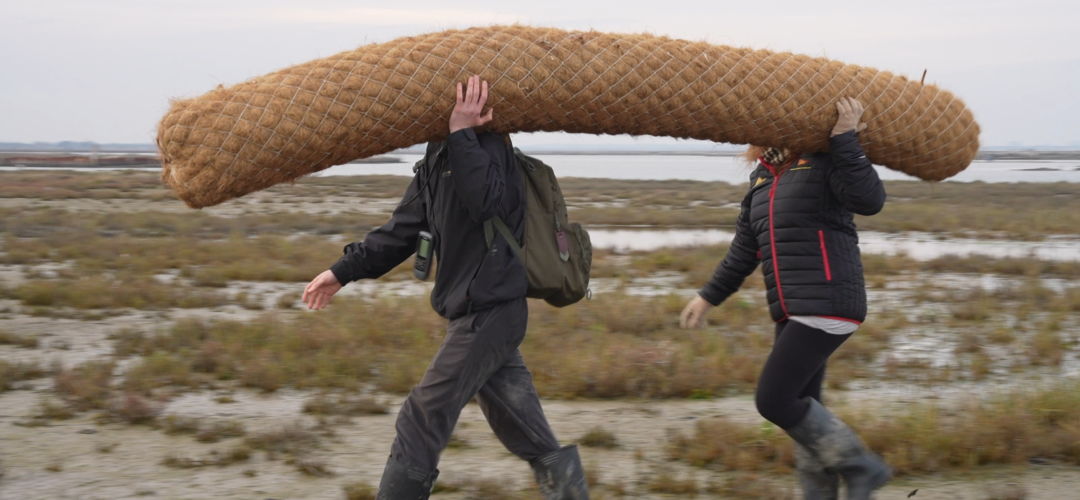Update from the WaterLANDS action site
Update from the WL action site

The WaterLANDS Action Site is a reclaimed salt marsh known as Lago Bastia 2. It is one of many infills constructed with dredged sediments, removed for port maintenance from the main shipping channel and lagoon inlets. The classification of this particular artificial marsh as “medium condition”, based on its current state in terms of erosion, vegetation cover and biodiversity, made it a suitable place for demonstrating the potential benefits of working with nature for wetland restoration that is at the heart of the WaterLANDS initiative. The overall aim is to connect stakeholders and the community, practical know-how and scientific research, experience and education, all in an innovative framework for successfully scaling up efforts — via new public/private partnerships — to revive the wetlands on a landscape scale throughout the lagoon.
Lago Bastia 2 was created around 2015 and the initial condition in terms of quota (relative to water level) and morphology didn’t create the right conditions for the characteristic salt marsh community of the Venice Lagoon to develop, leading to a low species richness in areas, and limiting the extent of channels and pools which support exchanges with the lagoon, essential for making the entire area more resilient to erosion. The wooden supports creating the edges have since collapsed in some parts and areas of sediment have been lost altogether.
A more ecologically minded version of complementary interventions constitute the WaterLANDS restoration management plan, aiming not only to stabilise sediment at the edges but also on the lower elevations to promote the re-establishment of important pioneer vegetation such as Spartina, Salicornia, and Sarcocornia, which in turn further stabilise sediments providing a natural vehicle to facilitate carbon sequestration and biodiversity enhancement. The ultimate goal is to prevent further erosion and promote the establishment of a more robust eco-morphodynamic system.
A combination of biodegradable materials are being used in this project, such as materassi di cocco (coconut fibre mattresses), as well as fascine (bundles of locally sourced branches) to create gentle barriers. These are placed strategically, based on vegetation vulnerability, site layout and elevation assessments. By disrupting strong flow and dissipating wave energy, these structures can promote sediment accumulation and allow seedling settlement, helping the aforementioned pioneer species to establish. More vegetation leads to further seedling establishment and stabilisation, with the goal of removing the need for additional infilling on sunken areas of the marsh. The search for materials has led to new contacts, whose specific experience and expertise will be important in informing the process of accumulating local knowledge and scaling up in the future.
The team will continue installing these materials over the next few weeks, and we are getting ready to conduct our post deployment monitoring, including an ecological survey of the general ecological condition and species present in the marsh, a drone survey to assess topography, and sediment analysis of granulometry and inorganic / organic carbon and nitrogen content. These can then be compared against the baseline surveys taken in the months leading up to the installations, and against future surveys over the coming years, to assess change and effectiveness of our restoration measures.
We are also embarking on various citizen science activities, including involving local middle school children, where they are introduced to the important concepts around which the WaterLANDS project is based, and then taken on an excursion to some sites around the lagoon, where they will record observations of plants and bird species, as well as take soil samples – connecting them with the scientific process behind restoration, and potentially adding to our dataset, resulting in a final event where their work will be curated and presented to their families, peers and the general public.
As with all Action Sites, we are also supporting an artist residency. Claudio Beorchia is a relational artist, interested in exploring and representing people’s connections to their surroundings. Within WaterLANDS he is developing some ideas strictly related to the restoration process.
Every year during the project we also organise a workshop to help rebuild connections between different types of “lagoon users”, gathering more information and insights as well as promoting new thinking about the value of wetlands to the development of Venice as a living city – and to making it less dependent on mass tourism and port activities. The workshops have adopted the deliberative approach advocated by Craig Bullock (University College, Dublin), Waterlands coordinator.
Mirroring our engagement work to build community expectations, regular steering group meetings are organised by us. Representatives from local and regional administrations as well as the State body responsible for safeguarding the lagoon participate too. Our aims are to:
- restore awareness of potential salt marsh restoration to improving the health of the lagoon system,
- offer more diversified employment opportunities,
- showcase the role of wetlands in addressing the climate and biodiversity crises, building on Venice's global visibility, and
- more generally build trust in the value for everyone and everything of nature restoration, community participation and public sector transparency.
◾